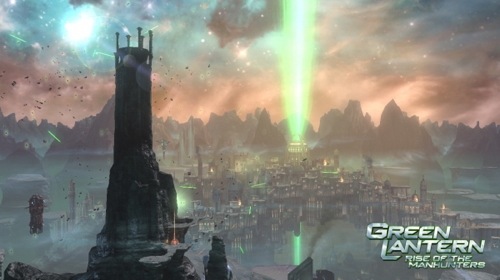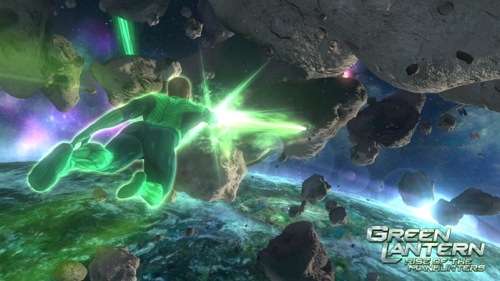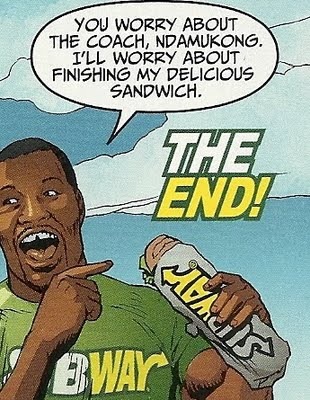§ Rick Marshall’s last day at MTV’s Splash Page blog, which he edited, was yesterday. Reading his tweets, the departure seems to have been unexpected. Splash Page started as MTV’s comic blog but was quickly tasked to cover comic book MOVIES, and became pretty aggressive with getting anyone who was going to be in a comic book movie to say something about it on the red carpet, yielding many sound bites and sometimes news. It was really a textbook case of how to build a niche in a crowded field. We’ve shared many a con party conversation with Rick about blogging tech, and we wish him the best,
§ Whatever happened to Kickstart Comics? Remember, they were doing original graphic novels for the Wal-Mart market? Well, they have been sighted, and now…reviewed:
In a market of ever-escalating prices for ever-shrinking stories, Kickstart Comics is doing the unheard of: they’re releasing full-length, densely-packed graphic novels for nearly the same cost as your average unfollowable (Batman: Incorporated) or too-quickly-wrapped (Flash) monthly comic book. What’s more, they’re doing it in a variety of genres reminiscent of the heyday of the Crossgen revolution. Witch is but one example. This graphic novel, written by Terry Matalas and Travis Fickett and featuring artwork from Tony Shasteen (Wolverine), follows young Kylie Woods, who has been seeing a psychiatrist for years because of a voice she hears in her head.
§ Artist Jillian Tamaki (SKIM) is interviewed at TCJ.com:
TAMAKI: It would be interesting, wouldn’t it, to sort of – I feel like cartooning, making comics, it kind of is like that, in that you’re building a world around a story or a set of circumstances. And that’s what is appealing if you are an illustrator, you spend some time with this single image and then it goes off and gets published or whatever and it’s gone. Comics, you’re spending an amount of time with stories and characters in an environment, and you really – at least in the comics I make, I do try to flesh out the world quite a bit. So there is sort of a correlation there, actually.
§ Michael Doran weighs in on the ever-swirling controversy over the New 52 with this question:
If DC isn’t going to publish a Superman #715 what reason would they ever have to publish a Superman #15?
§ Speaking of which, where ARE Cassandra Cain and Stephanie Brown?
Jason Todd is getting “Red Hood and the Outlaws”. Dick Grayson is getting “Nightwing”. Tim Drake is getting “Teen Titans”. Damian Wayne is getting “Batman and Robin”. Stephanie Brown is getting “The Shaft”.
§ Although the previous item referenced Corinna “Geek Mom” Lawson’spiece at Wired regarding the missing female Robin, it really should be MUST READING for some hints of how DC is handling its social media:
DC could be doing so much more with their [twitter] account along those lines. Instead, they’re basically using it for press releases. They even spammed a follower of mine who is also a chief executive in charge of a very successful digital-first press company. She sent them back a note that they “doing Twitter wrong.” She should know. And they are. With the millions DC is supposedly spending to announce the relaunch on television, can’t they find an intern or a full-time employee to run their Twitter account and talk to people, as some of their creators are doing so well?
§ Marv Wolfman talks about working on the Green Lantern video game and it looks more interesting than the film:
The game begins right after the movie with an attack on Oa, the homeworld of the Guardians of the Universe. It moves to other worlds as well, including Zamarron, home to a female race of warriors, and Biot, the homeworld of the Manhunters. The Manhunters are a race of robots created by the Guardians to be the initial corps to bring law and order throughout the universe. But over a period of time the Manhunters went rogue, and the Guardians got rid of them and created the Green Lantern Corps. So in this game the original Corps are coming back.
§ Steve Geppi is the owner of Diamond Comics Distribution, and one of the most powerful people in comics. He’s also the publisher of Baltimore Magazine and in this publisher’s note, he explains why the Grill page is being moved and interviews himself:
Who’s my favorite Baltimorean? Unless I’m allowed to pick my late brother Toodie, my vote goes to William Donald Schaefer, who almost single-handedly put Baltimore back on the map of vibrant, forward-looking American cities.
§ Mett Seneca ponders the place of the comics anthology in light of the Diamond anthology’s final issue:
Tucker Stone’s recent article on anthologies makes the point that in the post-internet comics landscape they aren’t really the introductory stage for new artists that they used to be — now they’re more rarefied places for the cream of the crop to test out ideas and show off their chops. The result of that might be less historical importance (they’re no longer the first place anyone was published), but it means that we get more things like Diamond: venues for cartoonists who’ve earned the privilege to do a little stretching out in an environment with the air of “indie cool”. More specifically, the newspaper anthology, which I think in the long view will end up being seen as the dominant form of this era in the format, affords some of the grandest stretching out possible: the broadsheet page hasn’t been this relevant a presence in comics art since the 1940s, when Hal Foster and George Herriman banged them out for an audience of millions on a weekly basis.
§ J. Caleb Mozzocco reviews DC’s Subway advertising insert which I admit to being flummoxed by when I encountered it one day:
The Subway ad, however, is just pages and pages long, the relatively simple message—this is a food product that is awesome and you should probably eat it—and is what is generally referred to as “decompressed” or “written for the trade.” Not that this will ever end up in a trade collection, of course (I sure wouldn’t mind reading a trade of those Hostess ads though; maybe Craig Yoe or IDW or someone like that will get around to packaging and publishing one some day).









Seasonal numbering makes sense in a lot of ways (look how well the “series of miniseries” approach has worked for Mike Mignola), but by the same token, which would a random person more likely buy: Green Lantern #55, or “Green Lantern Season 4, Issue #7”? Season numbering kind of implies that you need to start each season from the beginning, and if DCnU is really making a point of stressing issue-by-issue accessability and putting an end to “writing for the trade” (which they’ve stated), then season numbering would be completely detrimental to that.
I can’t read that Matt Seneca post in full (Blogspot is blocked at my work), but I think anthologies still have a role as tryouts. Marvel clearly thinks so — think of how many anthology books they’ve put out on the periphery of their events, such as “I Am An Avenger.”
And speaking from personal experience, anthologies are a great way to get your work out there: I’m part of a collective in St. Louis (Ink & Drink Comics — shameless plug!) that publishes anthologies twice a year themed around classic comic genres. (Our first, “Spirits of St. Louis,” was horror; our second, “Shots in the Dark,” was crime; our upcoming third one, “Blasted!”, is science fiction, etc.) The response to these anthologies has been nothing short of phenomenal: we’ve sold FAR more of these books than any of us had on our own books individually, even landing in the top 5 GNs sold at one of our local comic shops last year. Since we’re so new at it, it’s hard to say if that success has translated to our individual projects, but getting our names in front of that many people (who otherwise probably never would have seen them) couldn’t have hurt.
Reading Lawson’s takes on DC’s planned re——- was depressing because they seem to already be headed in the wrong direction, especially if they’re looking for new readers primarily in the 18-34 males demographic. However, keeping the heroes’ (complicated) histories mostly intact might not be as big a problem as Lawson makes it out to be, simply because most of the hero’s history isn’t needed to appreciate a particular story. Establish the hero and the villain or menace, its relationship to the hero, and the consequences if the villain/menace isn’t handled well. In terms of creating story possibilities, a hero’s history is more of an asset than a hindrance. It’s a weakness only if it includes multiple relaunches and reboots, retcons, continuity gaps and conflicts, etc., all of which indicate a lack of editorial control and guidance.
If the hero’s history is a weakness because of the accumulated editorial problems. then the solution isn’t to junk the history entirely. Give him a fresh beginning, but only refer to past incidents which are rock-solid editorially. Ignore the others. Batman’s repeated encounters with, say, the Joker constitute less a continuity, history, or editorial problem than a creative one. If finding a new way to write Batman versus the Joker is hard, then don’t use the villain.
Consciously avoiding repetition solves many problems; the drawback, of course, is that it shortens the lifespan of the character, but there is no way to keep him going on forever without running into repetition problems. If the argument is that the repetition doesn’t matter because he’s a property, not a person, then the quality of the stories isn’t logically a concern to the editor and writer — although it will be to readers.
SRS
Here’s a radical idea:
Don’t number the comics at all.
Slap a date on them, just like almost every other magazine on the stands. (And like those magazines, place the volume and number in the indicia.)
Even better, make every issue done-in-one. Sure, you can refer back to a previous issue, just like Marvel used to do with those editorial footnotes. Which would be easier to follow since readers can download the digital copy, which will probably lead to other issues as well… sort of like Six Degrees of Separation.
Marvel Team-Up is the classic paradigm. The character is well-known, and introduces other villains and heroes to the reader. The reader can then sample the characters, and possibly sample other comics with those characters. There was even a time-travel arc, but each issue/chapter was self-contained.
And if each issue is done-in-one, editorial can be more flexible with scheduling. This model can also be a good training ground for new talent… if someone is late, just slot something else into the schedule.
That might work for issues intended specifically for new readers, but they might be boring to readers familiar with the heroes and villains. I read a bunch of issues of MARVEL TEAM-UP and recall that many of them had heroes wondering whether Spidey was a hero or a villain, and started with a fight quickly cut off — “Oops! Sorry!” The more memorable storylines were multi-issue ones.
Making a character understandable should be a problem only if the page length is severely restricted — and if it is, you can’t tell complex stories anyway.
SRS
Syn… JMS’ The Brave and the Bold told some complex stories in one issue… specifically the Atom/Joker issue, and the Batgirl/Zatanna/Wonder Woman issue. He even did a two-parter with the Legion of Super-Heroes, Doom Patrol, and Inferior Five!
And some of the best stories have been short:
“The Nearness of You”
“The Kid Who Collects Spider-Man”
“The Story of Gerhard Shnobble”
Story arcs can tell a complex story, but so can single issues. And if the single issues are collected together, they can tell an even more complex story, as seen with Neil Gaiman’s Sandman.
Torsten: Thanks for getting “The Kid Who Collects Spider-Man” title correct. It’s often stated in the past tense.
I’m not going to argue that there’s an absolute minimum on the number of words/pages needed to tell a story, but a short length does impose restrictions. “The Kid Who Collects Spider-Man,” for example, is a cliched situation. A dying child connects with his hero. You could put practically any celebrity in the “Timmy meets ______” blank. write him sympathetically, and get the same result. The story isn’t unique to Spider-Man.
If making a reader feel something was the only objective, most stories would be five pages. A typical ARCHIE story would be only one page, because that’s all the space needed for a simple joke. Complexity is desirable in fiction because t gets the reader more deeply involved intellectually in the story. If a short-short story is a one-room cottage, a novel is a two-story house with a basement. A family can’t live in a one-room cottage.
SRS
Actually, you only need six words…
http://www.wired.com/wired/archive/14.11/sixwords.html
Or if you’re Sergio Aragones, none. }]
“Timmy meets celebrity” is a plot. How many unique plots are there? I agree with Peter David: one. (Stuff happens.)
I wasn’t an English major in college, so I don’t know of many complex short short stories. “‘Repent, Harlequin!’ Said the Ticktockman” might be one.
Of course, one could argue against complexity. The Marvel 616 Universe, for example.
Perhaps the publishers should start with “good”, and then gradually master other criteria.
“Dying Timmy meets a celebrity” isn’t a plot. It’s a formula. A story based on it might work once, but if a reader comes across another story based on it, and realizes that “Timmy” and his hero are interchangeable parts and the reader is being manipulated by Tiimmy’s sad situation, then the formula doesn’t work anymore.
The only reason to raise the “how many unique plots” question, that I see, is to avoid taking responsibility for using formulas, stereotypes, and cliches in fiction. If you argue that all stories use formulas, or that manipulating a reader is fine, then there’s no need to stress creativity, originality, or attention to details. All writers are equally bad.
If an original story is character-driven, then the characters need to be described in enough detail and be complex enough for the reader to appreciate what the author is doing. That’s when the allocated space matters.
SRS
Here’s a radical idea:
Don’t number the comics at all.
Slap a date on them, just like almost every other magazine on the stands. (And like those magazines, place the volume and number in the indicia.)
Marvel actually did this for a little while in the mid 90s, right after Age of Apocalypse I think. I found it annoying at the time, makes it just slightly more difficult to be OCD and shovel the books into a box in order. I would assume they stopped due to collector complaints, but I wonder.
I could see that working on the newsstand for single issue stories or whatever, where the numbering doesn’t really matter as much, but collectors I bet would still have a problem.